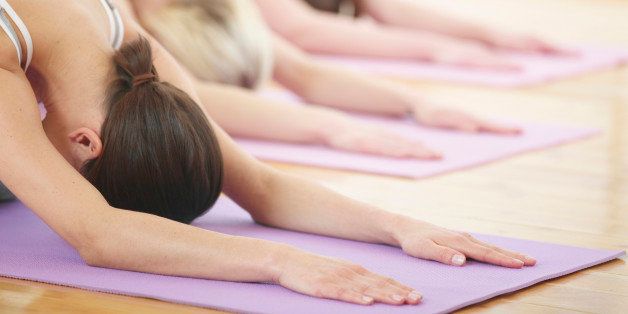
By Mary Bolster for KnowMore.tv
Given yoga's popularity, it's a wonder every American hasn't tried it. And maybe you're the last of your circle of friends who hasn't. Or maybe you took one class and didn't have a good experience.
Whatever the reason, if you're still curious and want to ensure a positive first-time, follow this checklist we created with Cyndi Lee, author of the yoga classic Yoga Body Buddha Mind, and Joe Kita, a yoga instructor in Schnecksville, PA.
Take a Beginner Class
Many first-time students make the mistake of going to an "all-levels" class or one that says, "everyone is welcome" and then find out that they're supposed to know the poses and be able to keep up with the pace. By contrast, in a beginner's class, the teacher will learn your name, ask if you have any health problems or physical limitations, and proceed to teach you the poses by breaking them down, says Lee. "If the teacher says, 'Watch me and do what I do,' that's not teaching. The teacher should be watching you and instructing you the whole time."
Find a Style that Suits You
Research the different styles of yoga and think about which one might appeal to you, suggests Kita. You might want something more aerobic like ashtanga or bikram. Or, you might prefer a style that emphasizes alignment like Iyengar. Ask your friends or look for a studio that offers free beginner classes in whatever style you think you might like. And don't hesitate to try a different style if you didn't like the first one.
Be Considerate in Class
There are some unwritten rules to follow in yoga class, say both Lee and Kita. Don't arrive late or leave early. Turn off your cell phone and remove any perfume or cologne. Refrain from eating at least two hours before class, suggests Lee. Many of the poses in yoga get the digestive system moving and a full stomach could translate into unpleasant bodily emissions. In savasana, which is the rest pose at the end of class, do your best to actually rest, says Kita. "It's not the time for sit-ups or fidgeting or checking your phone or otherwise making noise."
Wear Appropriate Clothes
Whatever you wear should be comfortable and not too baggy, says Lee. A baggy shirt will fall over your head in Downward Dog and baggy shorts, especially for men, could expose more than you bargained for in certain poses. Last but not least, take off your shoes and socks. Yoga is practiced barefoot.
Don't Gear Up
Most yoga studios provide everything you need to practice from mats to blocks, blankets, and straps. Just double check that they have the equipment you need. Once you decide yoga is for you, you can invest in your own gear then.
Listen to Your Body
Many newbies make the mistake of pushing too hard in yoga, says Kita. "People just push through pain and that's not what you want to do in yoga." Lee agrees and cautions students against turning yoga into a struggle. "Yoga is not about struggle or rejecting anything about yourself. It's about coming into balance." Tune into your body and with each pose, think about how you can bring it into balance whether by modifying or backing off the pose or using props.
Embrace Props
Props are your friends. They are not crutches. They help you maintain the integrity of a pose that you're either not strong enough or flexible enough to do on your own. They can help bring you into balance when you're struggling in a pose. And they can help keep you from getting injured because you aren't contorting your body in crazy ways to assume the pose.
Do Your Practice
Yoga is not a competition, says Kita. "Try not to compare yourself to anyone else in the room. It's just you and your body." When you find your attention wandering and you start to wish you could be like a more flexible student, bring your attention back to your breath and back to your own body, says Lee. "Ask yourself, 'What does my foot feel like right now? What is my breath like?'" Yoga, Lee says, is "an invitation to have an unabashed interest in your self. You're there to find your own balance and take that balance into your own life."
Give Yoga a Chance
Manage your expectations of yoga. You're not going to achieve nirvana after one class, says Kita. Also, instead of giving up after one disappointing class, try to pinpoint the problem. If it's the style or instructor, try a different studio or gym. If you were just having a bad day, take the class again. As Lee says, yoga is a process of getting to know yourself. "It can help you see where you're creating your own unhappiness and also where you are feeling good."
More from KnowMore.tv: